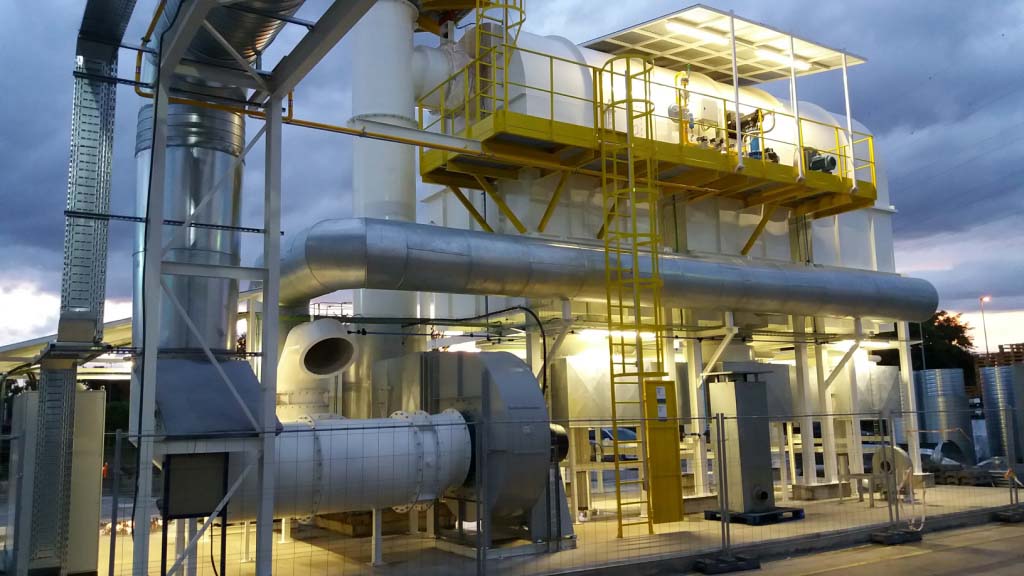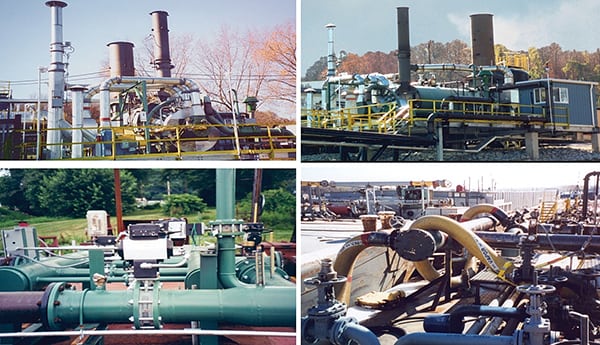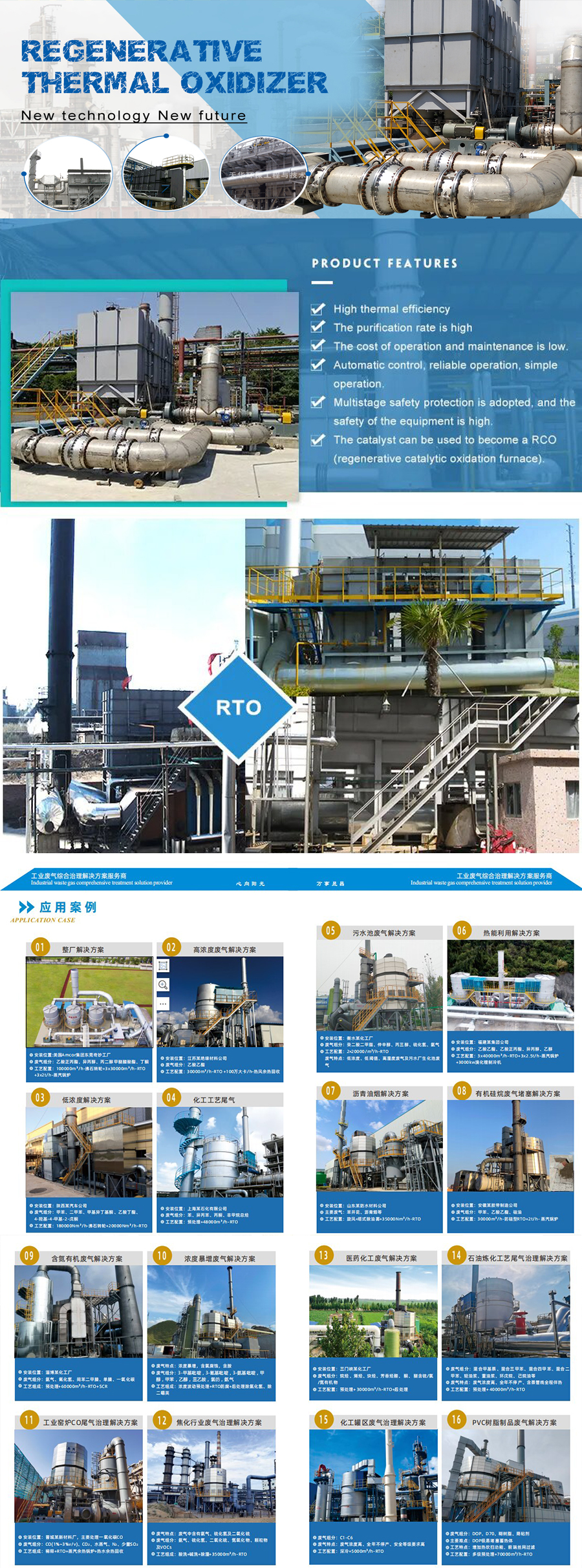Základní informace.
Model NO.
Úžasné RTO
Typ
Spalovna
Vysoká účinnost
100
Úspora energie
100
Low Maintenance
100
Easy Operation
100
Ochranná známka
Bjamazing
Přepravní balíček
Overseas
Specifikace
111
Původ
Čína
Kód HS
2221111
Popis produktu
RTO
Regenerační tepelný oxidátor
V porovnání s tradičním katalytickým spalováním; přímé tepelné okysličovadlo,; RTO má přednost ve vysoké účinnosti vytápění; nízké provozní náklady; a schopnost zpracovávat odpadní plyn s nízkou koncentrací velkého toku; Když je koncentrace VOC vysoká,; lze realizovat sekundární recyklaci tepla,; což výrazně sníží provozní náklady.; Vzhledem k tomu, že RTO může předehřívat odpadní plyn o úrovně prostřednictvím keramického akumulátoru tepla,; což by mohlo způsobit, že se odpadní plyn úplně zahřeje a popraská bez mrtvého rohu (účinnost čištění > 99 %);,;které snižují NOX ve výfukových plynech;; pokud je hustota VOC > 1500 mg/Nm3; když odpadní plyn dosáhne oblasti praskání; byla zahřátá na teplotu praskání pomocí tepelného akumulátoru; hořák bude za těchto podmínek uzavřen.;
RTO lze rozdělit na typ komory a rotační typ podle rozdílu provozního režimu.; Rotační typ RTO má výhody v systémovém tlaku,; teplotní stabilita; výše investice,; atd
| RTO types | Efficiency | Pressure change (mmAq); | Size | (max);Treatment volume | |
| Treatment efficiency | Heat recycle efficiency | ||||
| Rotary type RTO | 99 % | 97 % | 0-4 | small (1 time); | 50000Nm3/h |
| Three chamber type RTO | 99 % | 97 % | 0-10 | Large (1.;5times); | 100000Nm3/h |
| Two chamber type RTO | 95 % | 95 % | 0-20 | middle (1.;2times); | 100000Nm3/h |
Regenerative Thermal Oxidizer,; Regenerative Thermal Oxidizer,; Regenerative Thermal Oxidizer,; Thermal Oxidizer,; Thermal Oxidizer,; Thermal Oxidizer,; oxidizer,; oxidizer,; oxidizer,; incinerator,; incinerator,; incinerator,; waste gas treatment,; waste gas treatment,; waste gas treatment,; VOC treatment,; VOC treatment,; VOC treatment,; RTO,; RTO,; RTO,; Rotary RTO,; Rotary RTO,; Rotary RTO,; Chamber RTO,; Chamber RTO,; Chamber RTO
Adresa: 8 patro, E1, budova Pinwei, Dishengxi road, Yizhuang, ZheJiang, Čína
Typ podnikání: Výrobce/Továrna, Obchodní společnost
Rozsah podnikání: Elektrika a elektronika, Průmyslová zařízení a komponenty, Stroje na výrobu a zpracování, Metalurgie, Nerosty a energie
Certifikace systému managementu: ISO 9001, ISO 14001
Hlavní produkty: Rto, barevná lakovací linka, galvanizační linka, vzduchový nůž, náhradní díly pro zpracovatelskou linku, nanášecí stroj, nezávislá zařízení, dřezový válec, projekt renovace, dmychadlo
Představení společnosti: ZheJiang Amazing Science & Technology Co., Ltd je prosperující hi-tech společnost se sídlem v oblasti hospodářského a technologického rozvoje ZheJiang (BDA). V souladu s konceptem realistického, inovativního, zaměřeného a efektivního naše společnost slouží především průmyslu zpracování odpadních plynů (VOC) a metalurgickým zařízením Číny a dokonce i celého světa. Máme pokročilou technologii a bohaté zkušenosti s projektem zpracování odpadních plynů VOCs, jehož reference byla úspěšně aplikována v průmyslu nátěrových hmot, pryže, elektroniky, polygrafie atd. Máme také roky technologické akumulace ve výzkumu a výrobě plochých linka na zpracování oceli a má téměř 100 příkladů použití.
Naše společnost se zaměřuje na výzkum, návrh, výrobu, instalaci a zprovoznění systému čištění organických odpadních plynů VOCs a projekt modernizace a aktualizace pro úsporu energie a ochranu životního prostředí linky na zpracování ploché oceli. Můžeme zákazníkům poskytnout kompletní řešení pro ochranu životního prostředí, úsporu energie, zlepšování kvality produktů a další aspekty.
Zabýváme se také různými náhradními díly a nezávislými zařízeními pro barevnou lakovací linku, galvanizační linku, mořicí linku, jako je válec, spojka, tepelný výměník, rekuperátor, vzduchový nůž, dmychadlo, svářečka, vyrovnávač napětí, skin pass, dilatační spára, smyk, spárovačka , sešívačka, hořák, sálavá trubice, převodový motor, reduktor atd.

Can a regenerative thermal oxidizer be retrofitted into an existing facility?
Yes, regenerative thermal oxidizers (RTOs) can be retrofitted into existing facilities under certain conditions. Retrofitting an RTO involves integrating the system into the existing infrastructure and process flow of the facility to control emissions from industrial processes. However, the feasibility of retrofitting an RTO depends on several factors related to the facility and the specific requirements of the application.
Here are some considerations for retrofitting an RTO into an existing facility:
- Space Availability: RTOs typically require a significant amount of physical space for installation. It’s important to assess whether the facility has adequate space to accommodate the size and layout requirements of the RTO system. This includes considering the space needed for the RTO unit itself, associated ductwork, auxiliary systems, and access for maintenance.
- Process Integration: Retrofitting an RTO involves integrating the system into the existing industrial process. This integration may require modifications to the process flow, such as rerouting ductwork, adding or modifying exhaust points, or coordinating with existing pollution control equipment. The compatibility of the RTO with the existing process and the ability to seamlessly integrate the system should be evaluated.
- Auxiliary Systems: In addition to the RTO unit, auxiliary systems may be required for effective operation and compliance. These systems can include pre-treatment equipment such as scrubbers or filters, heat recovery units, monitoring and control systems, and stack emissions monitoring equipment. The availability of space and compatibility with existing infrastructure should be considered for accommodating these auxiliary systems.
- Utility Requirements: RTOs have specific utility requirements, such as the need for natural gas or electricity for heating the combustion chamber and operating the control system. The availability and capacity of utilities at the existing facility should be assessed to ensure they can meet the demands of the RTO system.
- Structural Considerations: The structural integrity of the facility should be evaluated to determine if it can support the additional weight of the RTO and associated equipment. This assessment may involve consulting with structural engineers and considering any necessary reinforcements or modifications.
- Regulatory Compliance: Retrofitting an RTO may require obtaining permits and complying with environmental regulations. It is essential to assess the applicable regulations and ensure that the retrofit meets the necessary compliance requirements for emissions control.
It is important to consult with experienced engineering firms or RTO manufacturers who can assess the specific requirements and constraints of the facility. They can provide detailed evaluations, feasibility studies, and design recommendations for retrofitting an RTO into an existing facility. Their expertise can help ensure that the retrofit is successful, cost-effective, and compliant with environmental regulations.

What are the noise level requirements for regenerative thermal oxidizers in residential areas?
The noise level requirements for regenerative thermal oxidizers (RTOs) in residential areas can vary depending on local regulations and specific circumstances. RTOs are typically designed to minimize noise emissions to ensure compliance with applicable noise regulations and to avoid disturbances to nearby residents. Here are some key points regarding noise level requirements for RTOs in residential areas:
- Noise Regulations: Different regions or jurisdictions may have specific noise regulations that apply to industrial equipment, including RTOs. These regulations typically define permissible noise levels and may vary depending on the time of day (daytime versus nighttime) and the zoning of the area (residential, commercial, or industrial).
- Noise Assessment: Prior to installing an RTO in a residential area, it is common practice to conduct a noise assessment. This assessment evaluates the expected noise levels generated by the RTO and compares them against the applicable noise regulations. The assessment considers factors such as the equipment design, operating conditions, and distance from residential properties.
- Noise Mitigation: If the noise assessment indicates that the RTO may exceed the permissible noise levels, mitigation measures can be implemented. These measures may include the use of noise barriers or enclosures around the RTO, acoustic insulation, or the installation of sound-absorbing materials to reduce noise propagation. The goal is to ensure that the noise emissions from the RTO are within the acceptable limits specified by the regulations.
- Community Engagement: In some cases, community engagement and communication with nearby residents may be necessary to address concerns related to noise emissions. This can involve sharing information about the RTO’s design, operation, and noise mitigation measures to assure residents that their concerns are being addressed and that the RTO is in compliance with the applicable regulations.
It is important to note that specific noise level requirements and mitigation measures can vary depending on the local regulations and the unique characteristics of the residential area. Consulting with local authorities, environmental agencies, or acoustic specialists can provide guidance on the specific noise level requirements and mitigation strategies that apply to RTO installations in residential areas.
In summary, the noise level requirements for RTOs in residential areas are typically governed by local regulations. Conducting a noise assessment, implementing noise mitigation measures if necessary, and engaging with the community can help ensure compliance with noise regulations and minimize disturbances to nearby residents.

What are the maintenance requirements for a regenerative thermal oxidizer?
Maintaining a regenerative thermal oxidizer (RTO) is essential to ensure its optimal performance, longevity, and compliance with environmental regulations. Here are some key maintenance requirements for an RTO:
- Regular Inspections: Conduct routine inspections to identify any signs of wear, corrosion, or damage to the RTO components. This includes inspecting valves, dampers, fans, combustion chambers, heat exchangers, and ceramic media beds. Inspections help detect potential issues early and allow for timely repairs or replacements.
- Cleaning and Replacement of Components: Clean or replace components as needed to maintain proper functionality. This may include cleaning clogged or fouled heat exchanger surfaces, replacing damaged or worn-out valves and dampers, and periodically replacing the ceramic media beds if they become degraded or contaminated.
- Monitoring Operating Parameters: Regularly monitor and record operating parameters such as temperature, airflow, pressure differentials, and gas concentrations. Deviations from normal operating ranges can indicate potential problems or inefficiencies that require attention.
- Calibration of Instruments: Calibrate instruments and sensors used for monitoring and control purposes to ensure accurate measurement of parameters such as temperature, pressure, and flow rates. Proper calibration helps maintain reliable and precise operation of the RTO.
- Cleaning of Heat Recovery System: Clean the heat recovery system, including the heat exchanger surfaces, to remove any accumulated particulate matter or fouling. This ensures efficient heat transfer and prevents the buildup of deposits that can reduce the RTO’s performance.
- Compliance with Safety Standards: Adhere to safety standards and guidelines for working with the RTO. This includes proper lockout/tagout procedures during maintenance activities, wearing appropriate personal protective equipment, and following safety protocols to minimize risks to personnel and equipment.
- Documentation and Record-Keeping: Maintain comprehensive records of maintenance activities, inspections, repairs, and any modifications made to the RTO. Documentation helps track the equipment’s history, aids in troubleshooting, and provides a record of compliance with regulatory requirements.
It’s important to note that the specific maintenance requirements may vary depending on the RTO manufacturer’s recommendations, the design of the system, the operating conditions, and applicable regulatory requirements. Following the manufacturer’s guidelines, conducting regular inspections, and implementing a proactive maintenance program tailored to the specific RTO are crucial for ensuring its reliable operation and longevity.

editor by Dream 2024-04-19
